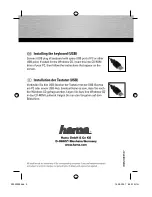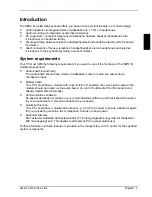
4. orGaN | 13
vIBrato
the original instrument has two basic vibrato modes; “light” and
“Heavy”, with different rates for each mode. there are several types of
vibrato and choruses available for the Farf model on the Nord Electro 6,
which are activated using the
ON
button in the vibrato section.
the
V1
,
V2
and the
V3
settings are the ones that are modeled after the
original instrument’s.
PIPE orGaNs
PIPE 1
the
PIPE1
organ model is not designed to imitate any existing instru-
ment, but rather to be a useful and appealing “all-purpose” organ, which
works equally well with or without rotary speaker. In some ways its
sound is similar to that of the B3 organ – but without any of its electro-
mechanical behaviors and artifacts.
PIPE 2
the
PIPE2
organ model faithfully recreates a
principal
pipe section - the
sets of metal pipes, or ranks, that commonly make up the backbone of
a pipe or church organ. While other ranks may attempt to recreate the
sounds of other instruments (flutes, trumpets, strings etc.) the principal
sound is non-imitative and unique to the pipe organ.
PIPE 1&2 cHorUs
activating
VIBRATO/CHORUS
for the Pipe 1 or 2 model will switch to a
variation which is tuned with less precision. this produces chorus-like
effects, slight dissonances and arguably more realism when combining
registers.
PIPE 1&2 rEGIstErs
the pipe lengths available for both Pipe models correspond to those of
the B3 model, ranging from 16 feet to 1 foot.
PrEsEt
there are two sets of drawbars available for each organ
manual – the default drawbar set (Preset lEd not lit)
and the Preset. this provides a quick way of changing
between two organ sound variations, without having to
change programs.
to switch between the two drawbar settings press the
PRESET
button.
the Preset lEd being lit indicates that the Preset is active.
In order to modify the Preset, press down on the button – as indicated
by the
”
6
”
symbol – while adjusting the drawbars and other settings.
When in the non-Preset mode, the current drawbar positions can be
stored to the Preset by pressing
COPY TO PRESET
(shift + Preset).
MaNUal orGaN
the
MANUAL ORGAN
(shift + octave down) can be
thought of as a separate – program independent – organ,
the settings of which are in always sync regardless of
which program it is loaded from. additionally the actual
positions of the drawbars are always used when Manual
organ is activated or loaded from a program.
By using Manual Organ and the External KBD to Lo feature (see
page 17), a separate keyboard could be used to control the or-
gan on a per-program basis in a manner where the current drawbar
positions are always used, and all other organ settings remain the
same, regardless of which program is loaded.
dUal orGaN
Press
DUAL ORGAN
(shift + Edit lower Manual) to
instantly create a double manual organ setup, with the
keyboard split into two zones. the lower (
LO
) manual
will be on the left side of the split point and the upper
(
UP
) manual to the right.
to adjust the keyboard split position, press down on the
KBD SPLIT
button in the Program area and use the dial. see page 16 for more
information on this.
EdIt loWEr MaNUal
Press the
EDIT LOWER MANUAL
button to focus the lower manual for
editing and drawbar interaction. to return to the upper manual, simply
press the button again. In dual organ mode the drawbar representa-
tions in the display will show which manual is currently focused by “gray-
ing out” the other one. the example below shows a live program set up
as a dual organ split in B3 Bass mode, with the upper manual focused
for editing.
M
The Edit Lower Manual control is only available in Dual Organ
mode.
rotarY sPEaKEr
the rotary speaker controls are logically placed next to the organ
section. Its settings are described in detail in the Effects chapter on
page 21.
OFFSET PRINT CMYK VERSION
OFFSET PRINT CMYK VERSION
260
Live A:3
OFFSET PRINT CMYK VERSION
Summary of Contents for Nord Electro 6
Page 32: ......













































